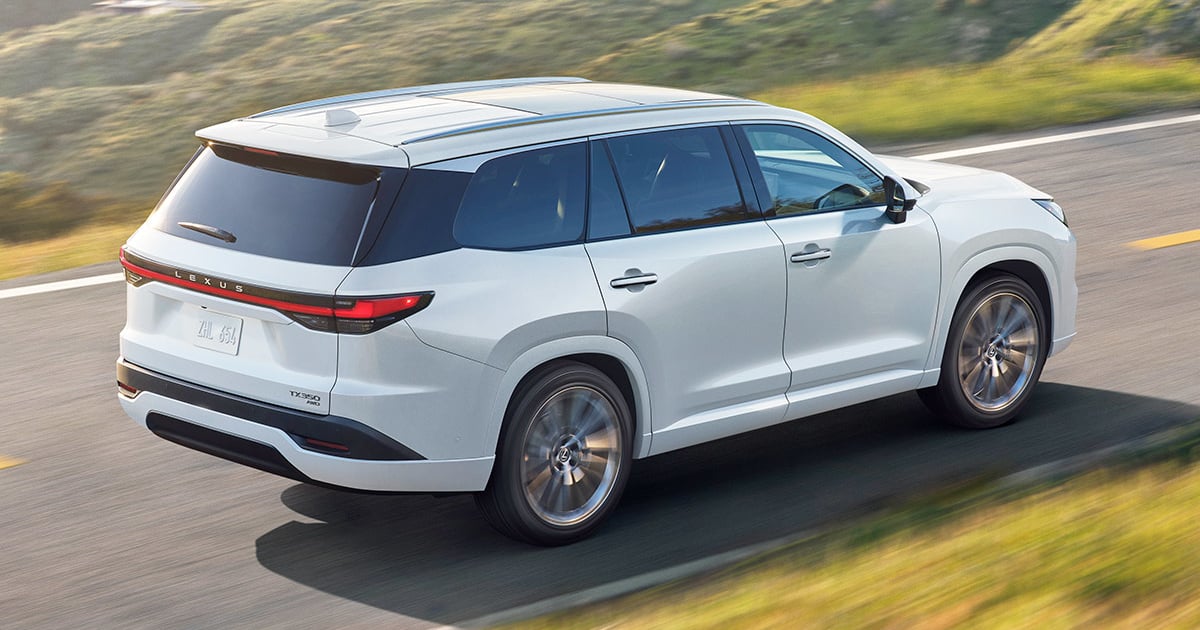
AUSTIN, Texas — With the introduction of two of its big haulers here, Lexus is fulfilling two big needs.
First, the new TX nameplate gives the luxury brand a larger crossover with comfortable third-row seating to compete with the likes of the Volvo XC90, BMW X7, Audi Q7, Lincoln Aviator and Cadillac XT6.
Second, the large Lexus GX SUV gets a heavy dose of modernization with its first redesign since the 2010 model year. In addition to moving to Toyota Motor’s TNGA-F body-on-frame platform, the GX features the debut of Lexus’ Overtrail trim package.
The TX, built on the automaker’s TNGA-K platform, slots above the RX midsize crossover and below the GX. In similar fashion as the RX, the TX will be available with a variety of powertrains and in a number of trims: Standard, Premium, Luxury and F Sport Performance.
The entry-level TX 350 has a 2.4-liter turbo-four gasoline engine that gets 275 hp and 317 pound-feet of torque. It has an eight-speed automatic transmission and is available in either front-wheel or all-wheel drive. Estimated combined fuel economy is 21 mpg.
The TX 500h has a 2.4-liter inline-four gasoline-electric hybrid system that gets 366 hp and 409 pound-feet of torque. It has a six-speed automatic transmission and will combine Lexus’ Direct4 awd system with dynamic rear steering to enhance vehicle maneuverability and stability, the brand says. Combined fuel economy is estimated at 24 mpg.
The TX 550h+ plug-in hybrid rounds out the lineup. It is equipped with a 3.5-liter V-6 engine teamed with a continuously variable transmission and Direct4 awd that produces 406 hp; its torque rating was not revealed. Combined fuel economy is estimated at 30 mpg, and it has 33 miles of electric-only range.
The TX will be Lexus’ first model assembled at Toyota Motor North America’s plant in Princeton, Ind. The 350 and 500h will be in showrooms this fall. The plug-in hybrid will go on sale later. Pricing was not announced.
The TX “fills a gap that we’ve needed to be filled for a long time,” John Iacono, a partner in Bram Auto Group in the New York City area and chairman of the Lexus dealer council, told Automotive News in January. “It’s a people mover. It’s the right size. It’s a car-based vehicle that is going to give the ride that that segment is looking for, and it has the size that we were missing.”
The GX, which has been in the U.S. since 2002, is entering its third generation with a ground-up redesign and a pair of new trims that bolster off-road character and capability.
The GX will come in Premium, Premium+, Luxury and Luxury+ trims, as well as Overtrail and Overtrail+ trims, a first for Lexus.
Each of the trims is equipped with a twin-turbo, 3.4-liter V-6 engine that generates 349 hp and 479 pound-feet of torque, and each has a 10-speed transmission and awd. The new engine is more powerful than the current generation’s 301-hp V-8. Estimated combined fuel economy is 17 mpg.
A hybrid GX will debut later, Lexus said.
The Luxury version tows up to 6,990 pounds, and Luxury+ tows up to 6,780 pounds. Premium, Premium+, Overtrail and Overtrail+ boost that capacity to 8,000 pounds.
The 2024 GX has a wider stance than its predecessor: 3.74 more inches in the pair of Luxury and Premium trims, and 4.52 inches in the Overtrails.
Besides additional towing ability and width, the Overtrail and Overtrail+ have 33-inch tires mounted on 18-inch wheels to improve off-road performance, exclusive two-tone exterior color combinations and an electronic locking rear differential. The Overtail+ will have “an exclusive seat design for optimal off-road comfort,” with available driver and front-passenger massage seats and a driver power cushion extender.
The GX will be assembled in Tahara, Japan, and go on sale in early 2024. Pricing has not been announced. The 2023 GX starts at $59,275 including shipping.
The GX has been a consistent performer for Lexus following the Great Recession, when U.S. volume bottomed out at 6,235 in 2009. In 2021, it crossed the 30,000 threshold for the first time since 2005. Sales in 2022 totaled 29,945.
Larry P. Vellequette contributed to this report.